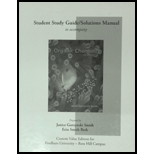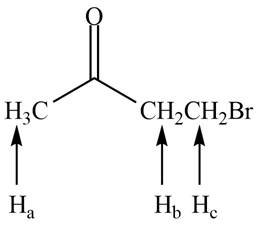
Concept explainers
(a)
Interpretation:
The number of peaks for each indicated proton is to be predicted.
Concept introduction:
The number of NMR signal in a compound is equal to the number of chemically non-equivalent protons present in that compound. Protons which are present in the same chemical environment that is between the same group of atoms are known as chemically equivalent protons and in
Answer to Problem 14.13P
The given compound shows two signals in
Explanation of Solution
The number of signals in each compound is equal to the number of hydrogen atoms present in a different chemical environment. The given compound is
It has two different types of non-equivalent protons shown in red color. Therefore, it gives two signals in
The given compound shows two signals in
(b)
Interpretation:
The number of peaks for each indicated proton is to be predicted.
Concept introduction:
The number of NMR signal in a compound is equal to the number of chemically non-equivalent protons present in that compound. Protons which are present in the same chemical environment that is between the same group of atoms are known as chemically equivalent protons and in
Answer to Problem 14.13P
The given compound shows two signals in
Explanation of Solution
The given compound is shown below.

Figure 1
It has two non-equivalent protons. Therefore, it gives two signals in
The signal
The given compound shows two signals in
(c)
Interpretation:
The number of peaks for each indicated proton is to be predicted.
Concept introduction:
The number of NMR signal in a compound is equal to the number of chemically non-equivalent protons present in that compound. Protons which are present in the same chemical environment that is between the same group of atoms are known as chemically equivalent protons and in
Answer to Problem 14.13P
The given compound shows three signals in
Explanation of Solution
The given compound is shown below.

Figure 2
It has three non-equivalent protons. Therefore, it gives three signals in
The signal
The given compound shows three signals in
(d)
Interpretation:
The number of peaks for each indicated proton is to be predicted.
Concept introduction:
The number of NMR signal in a compound is equal to the number of chemically non-equivalent protons present in that compound. Protons which are present in the same chemical environment that is between the same group of atoms are known as chemically equivalent protons and in
Answer to Problem 14.13P
The given compound shows two signals in
Explanation of Solution
The given compound is shown below.

Figure 3
It has two non-equivalent protons. Therefore, it gives two signals in
The signal
The given compound shows two signals in
(e)
Interpretation:
The number of peaks for each indicated proton is to be predicted.
Concept introduction:
The number of NMR signal in a compound is equal to the number of chemically non-equivalent protons present in that compound. Protons which are present in the same chemical environment that is between the same group of atoms are known as chemically equivalent protons and in
Answer to Problem 14.13P
The given compound shows two signals in
Explanation of Solution
The given compound is shown below.

Figure 4
It has two non-equivalent protons. Therefore, it gives two signals in
The signal
The given compound shows two signals in
(f)
Interpretation:
The number of peaks for each indicated proton is to be predicted.
Concept introduction:
The number of NMR signal in a compound is equal to the number of chemically non-equivalent protons present in that compound. Protons which are present in the same chemical environment that is between the same group of atoms are known as chemically equivalent protons and in
Answer to Problem 14.13P
The indicated protons
Explanation of Solution
The given compound is shown below.

Figure 5
It has three non-equivalent protons. Therefore, it gives three signals in
The signal
Hence, the indicated protons which are shown in red color shows doublet and triplet peaks.
The indicated protons
Want to see more full solutions like this?
Chapter 14 Solutions
Organic Chemistry -Study Guide / Solution Manual (Custom)
- a. Which proton or set of protons in each of the following compounds is the least shielded?b. Which proton or set of protons in each compound is the most shielded?arrow_forwardWhat splitting pattern is observed for each proton in the following compounds?arrow_forwardGive the Proton NMR Interpretation of the peaksarrow_forward
- Based on this HNMR of Acetylferrocene, explain why the hydrogens labeled are equivalent, why the splitting pattern appears the way it does on the HNMR, and why the chemical shift of each signal appears in that order?arrow_forwardwhats the relationship between the indicated protons?arrow_forwardHow can I find the numbers of hydrogens per each peak on the NMR chart of the image?arrow_forward
 Organic Chemistry: A Guided InquiryChemistryISBN:9780618974122Author:Andrei StraumanisPublisher:Cengage Learning
Organic Chemistry: A Guided InquiryChemistryISBN:9780618974122Author:Andrei StraumanisPublisher:Cengage Learning
